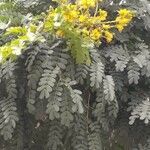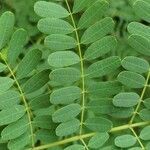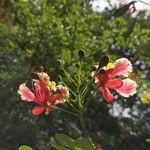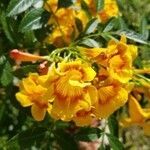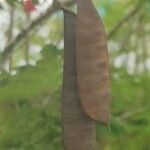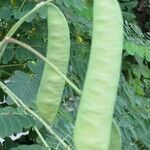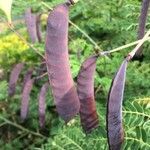Shrub or small tree, up to 5 m tall, glabrous; branchlets unarmed or with a few straight prickles. Stipules subulate, c. 2 mm long, caducous. Leaves: rachis 20-40 cm; pinnae 5-9 pairs, often with a small subulate stipel (c. 0.5 mm long) between the pair. Leaflets opposite, 6-12 pairs per pinna, petiolulate (1-2 mm), oblong or elliptic-oblong, 9-30 (-35) by 5-15(-23) mm; base unequal, rounded; apex rounded to retuse. Inflores-cences axillary and terminal, racemose, sometimes paniculate, 20-50 cm long, rachis glabrous, rarely with a few straight prickles; bracts c. 5 by 0.5 mm; pedicels 70-100 mm, not articulated. Hypanthium c. 2 mm deep and 4 mm wide. Sepals 10-15 by 5-7 mm, ciliate. Petals yellow or flame-red, or red with a yellow margin, 10-25 by 6-8 mm, clawed (claw up to 15 mm long). Stamens very far exserted; filaments 55-75 mm; anthers 1.5-2.5 mm long, glabrous. Pistil about as long as the stamens; ovary 15-20 mm long, 8-12-ovuled; style 50-65 mm; stigma ciliate. Pods (pedicels 70-100 mm), 6-9 (-11) by 1.5-2 cm, dehiscent, septate, more or less woody, often widest at the rounded top, beaked, 8-10-seeded. Seeds slightly rectangular, 8-10 by 6-8 mm, black, dull.
flowered; bracts similar to stipules, caducous; lower pedicels elongate, not uncom-monly 7-8 cm. long, glabrous. Flowers ornamental, red to yellow; calyx-tube narrowly turbinate, 3-4 mm. long, the pedicellar stalk subarticulate a few mm. below the tube; mature calyx-lobes ovate or lanceolate to obovate, about 1 cm. long, glabrous, imbricate in bud, the outer calyx-lobe cucullate and somewhat larger; petals free, obovate, about 2 cm. long, glabrous, clawed; stamens 10, in-serted with petals on rim of calyx-tube, strongly exserted; filaments free, about 5 cm. long, glabrous except basally where viscid-pubescent; anthers ovate, 1-2 mm. long, versatile, bilocular, longitudinally dehiscent; ovary linear, glabrous, stipitate from base of calyx-tube. Legume linear-oblong, up to 12 cm. long, usually some-what wider apically than basally, obliquely acute both apically and basally, short-stipitate, flattened, glabrous, elastically dehiscent; seeds ovate, transverse.
Shrubs or small trees. Branches green or farinose-green, smooth, with scattered, sparse prickles. Leaves 12-26 cm; pinnae 4-8 pairs, opposite, 6-12 cm; petiolules short; leaflets 7-11 pairs, oblong or obovate, 1-2 cm × 4-8 mm, base oblique, apex emarginate, sometimes acute. Racemes subcorymbose, terminal or axillary, lax, to 25 cm. Pedicels unequal in length, 4.5-7 cm. Receptacle concave to turbinate, glabrous. Sepals 5, glabrous, lowest one ca. 1.4 cm, others ca. 1 cm. Petals orange-red or yellow, orbicular, 1-2.5 cm, margin wavy, with claw subequal to limb in length. Stamens very far exserted; filaments red, 5-6 cm, thick and hairy in basal part. Ovary glabrous; style orange-yellow, long, 5-6.5 mm. Legume blackish brown when ripe, oblanceolate-oblong, narrow and thin, 6-10 × 1.5-2 cm, not winged, glabrous, indehiscent, apex rounded, upper suture ending in a sharp beak. Seeds 6-9. Fl. and fr. year-round. 2n = 24, 28.
Shrub or small tree 2–5 m high; branchlets unarmed or sparsely prickled. Leaves ± unarmed, c. 20–30 cm long, with 3–9 pairs of pinnae, each with 6–12 pairs of shortly stalked leaflets; leaflets oblong, 5–25 mm long, oblique at base, rounded to emarginate at apex; stipules minute, caducous. Racemes axillary, many-flowered, 15–40 cm long, glabrous, occasionally branched; pedicels 5–7 cm long. Petals 15–25 mm long, yellow and/or orange-red, often with yellow margins; upper petal smaller with a slender claw 10–15 mm long. Stamens 5–7.5 cm long, slender, greatly exserted, hairy at base. Fruit linear-oblong or broader apically, 8–10 cm long, flattened, glabrous, dehiscent, dark brown. Seeds 8–9, obovoid.
Lightly or scarcely armed shrub or small tree, the branchlets glabrous. Leaves moderately large, twice-pinnate; petiole 2-8 cm. long, terete, eglandular, glabrous; rachis like petiole, up to 2 or more dm. long; stipules lanceolate, minute, caducous; pinnae up to 8 or more pairs, opposite on the rachis; leaflets about 10 pairs to the pinna, subopposite, mostly oblong, 10-23 mm. long and 5-10 mm. wide, rounded apically, obtuse and somewhat inequilateral basally, glabrous, membranaceous, petiolulate. Inflorescence usually terminal, a corymbose raceme, several-to many-
A bush or shrub. It grows 3 m tall. It has a single stem at the base. It branches widely. The leaves are compound and are divided twice. There can be 12 pairs of leaflets. These are 2 cm long. There are long flower spikes on the ends of most branches. The flowers have long stalks. The flowers can be red, pink, gold or yellow. The petals have wavy edges. The stamens are long. The fruit are flat, hanging pods. They are 12 cm long. They are green and turn dark brown. The pods twist open on the tree.
